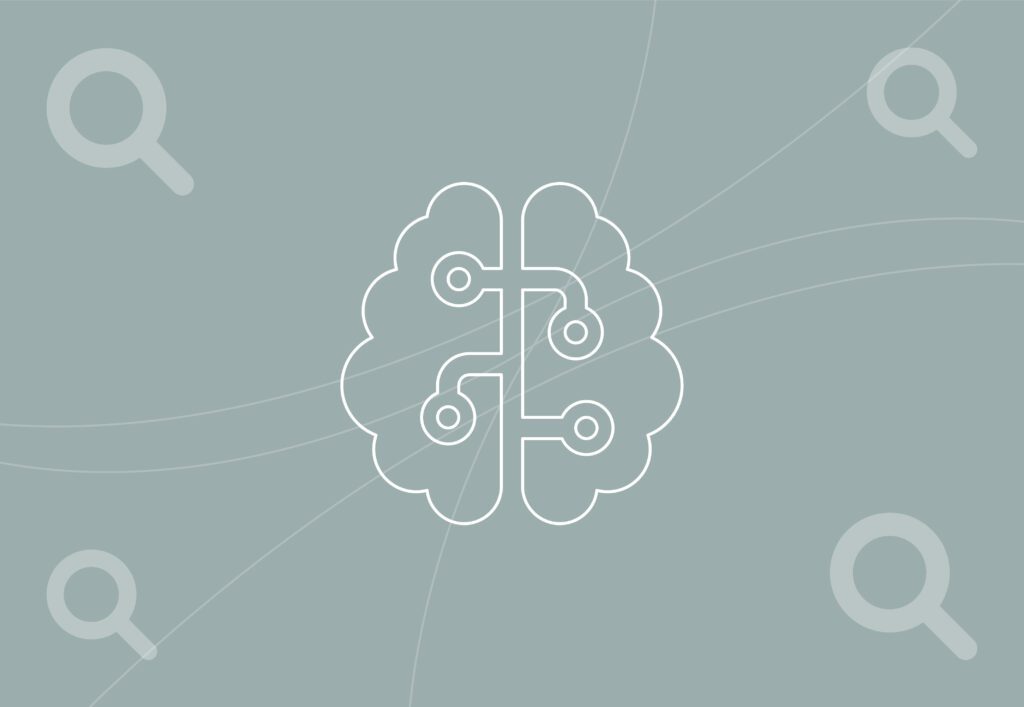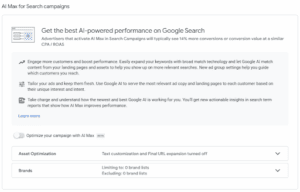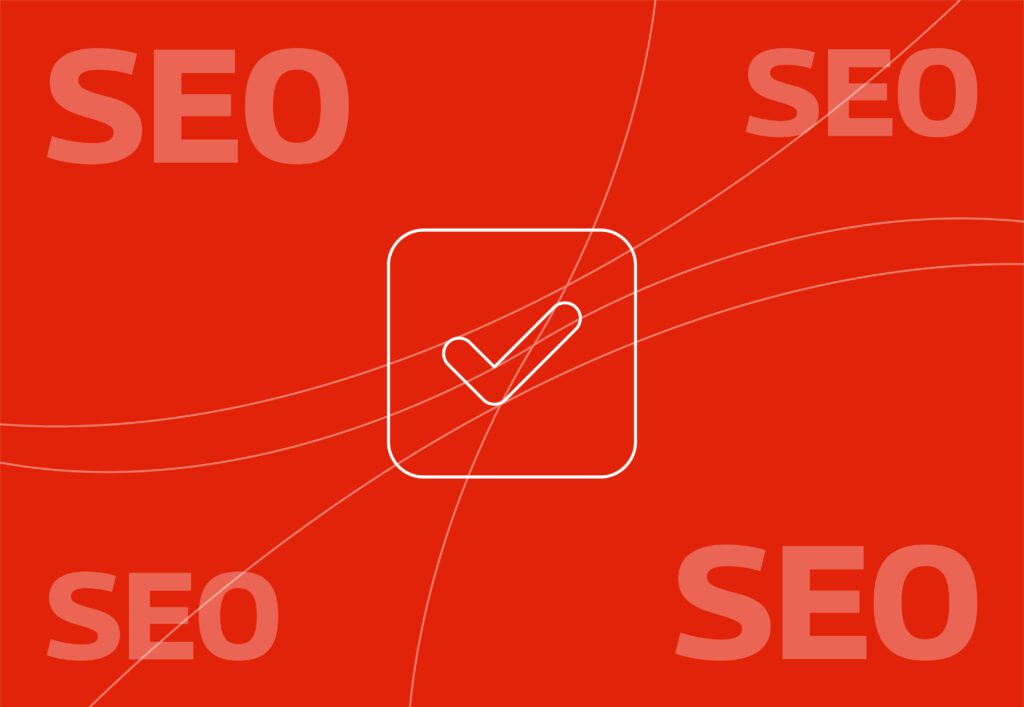
Using AI Max to enhance your search campaigns

What is AI Max?
AI Max is Google’s latest AI-driven update, specifically for search campaigns. Google claims it is crafted to transform how advertisers approach digital advertising. AI Max leverages advanced machine learning in order to optimise targeting, fine-tune creative assets and enhance overall campaign performance. Unlike Performance Max campaigns, AI Max isn’t its own campaign but an AI-driven feature within Search campaigns.
In traditional Search campaigns, there is heavy reliance on manual keyword selection, and bidding strategies often limit how quickly and accurately ads can adapt to what users need at any given point. However, with AI Max, Google uses AI to better understand user intent, expand keyword coverage beyond those selected by advertisers and adapt ad creatives. It does all this by analysing the advertiser’s landing pages, current ad copy and user signals to deliver ads that are more likely to resonate with the user and thus convert.
One of the key strengths of AI Max appears to be its ability to open up access to high-performing search queries that may not have been considered in a traditional campaign build. The blend of broad match with keywordless AI targeting should uncover any hidden or missed opportunities. Alongside this, the updated creative features mean headlines and descriptions are tailored to match each user’s search query in real time.
AI Max also includes improved reporting tools, including asset-level performance insights, brand controls, and geographic intent targeting. Ultimately, AI Max seems to focus on helping advertisers scale their search campaigns with the use of AI but also providing that necessary level of control required by advertisers. It allows for wider reach and smarter automation while still providing the control needed to meet campaign objectives. However, more AI will mean more reach, which also means more chance of unwanted ad placement, therefore meaning human input will still be extremely important in keeping on top of search queries and exclusions.

How AI Max will change search campaigns
AI Max introduces several advanced new features that have the ability to redefine how advertisers approach and execute search campaigns. Through moving beyond the limitations of traditional keyword targeting and ad customisation, it offers a smarter more adaptive way to reach high intent users.
- Expanded keyword matching: Traditional search campaigns rely on exact match, phrase match and broad match keywords to control when ads appear. While effective, this method can miss out on valuable queries outside the pre-selected keywords. AI Max goes beyond this by using a combination of broad match and keywordless AI targeting. It analyses landing pages, ad copy and past performance in order to identify potentially high-performing queries that advertisers may not have considered. This should then allow campaigns to continuously access new, relevant traffic that may have previously been off the radar.
- Dynamic Ad Creative optimisation: One of AI Max’s key capabilities is its real-time ad creative adaption. Headlines and descriptions are adjusted dynamically based on the user’s intent at the moment of search. It is expected that this level of responsiveness could make a huge difference to performance by improving click-through and conversion rates through making ads more relevant, engaging and aligned with the users needs.
- Final URL expansion: Instead of directing users to a static landing page, it is suggested that AI Max dynamically selects the most relevant page on your website based on the user’s search query. This would then ensure that users land on the most contextually appropriate page, thus improving engagement and conversion rates.
- Improved reporting and transparency: A common concern with AI automation is the lack of transparency. AI Max is expected to address this by providing detailed reporting on search term performance, asset effectiveness and conversion sources, allowing advertisers to make data-driven optimisation decisions.
Overall, AI Max seems to offer flexibility, scale and intelligence to search campaigns without removing the control that advertisers really value.
Is AI Max similar to Performance Max?
Whilst at first glance AI Max may appear similar to Performance Max, there are a few key differences that set the two apart. Both utilise Google’s AI driven technology to enhance campaign performance, but how they’re structured and the level of control they offer advertisers varies quite significantly.
Where Performance Max is a standalone campaign type with its own separate identity, designed to run independently across all of Google’s channels, including Search, Display, YouTube, Gmail and Discover, AI Max is an enhancement within existing Search campaigns. AI Max is an opt-in feature that provides advertisers more flexibility in how they choose to incorporate AI features within their search strategy.
A large aspect of AI Max is the use of keywordless technology, using a combination of machine learning, search term matching, and landing page analysis to identify relevant queries. However, PMax doesn’t use keyword targeting and relies on audience signals, creative assets and conversion goals to decide where and when ads should appear.
Both campaign types make use of AI-generated assets; however, PMax leans more heavily into full automation, offering options for fully generated creatives. Where AI Max focuses on dynamic text adjustments, creating headlines and descriptions tailored to user intent without building an ad from scratch.
While PMax distributes ads across multiple Google properties, syncing landing pages according to URL expansion, AI Max focuses on Search only. Using dynamic URL selection to send users to the most relevant page based on query intent.
A real pain point within Performance Max campaigns is the lack of control and transparency; advertisers have limited control over both ad placements and targeting. However, AI Max addresses this by allowing for granular reporting, manual overrides and clearer insights, giving advertisers more confidence in their campaign performance.
Overall AI Max appears much more transparent, at this stage, and is of course integrated within Search campaigns. Whereas Performance Max is a fully automated campaign type that spans multiple Google properties.
How to implement AI Max within search campaigns?
Implementing AI Max seems to be a fairly straightforward process that doesn’t require building a brand new campaign. Instead, AI Max is an enhancement which can be applied directly within an existing Search campaign.
- Access campaign settings: Navigate to the campaign settings for the search campaigns you have chosen to test AI Max on. This could either be an existing campaign that you want to enhance with AI features or a newly created one designed with AI Max in mind.
- Activate AI Max: Toggle on the AI Max feature within the campaign settings. This will enable several AI-powered enhancements, including search term matching, dynamic ad creative optimisation and final URL expansion.
- Adjust Ad Group settings: Review each individual ad group to ensure that the selected targeting, creative assets and keyword strategies align with the campaign objectives. Ensuring consistency with campaign goals and messaging will be essential in giving AI the right foundations to work from.
- Monitor performance and optimise: Once the AI Max has been activated it is key to monitor performance metrics such as conversion rates, click-through-rates and search term effectiveness. It is essential that advertisers use Google Ads reporting tools to refine the strategy and make necessary optimisations. Even though AI is handling much of the optimisation, the best results are likely to come from a balance of automation and human strategy. Advertisers should be sure to keep a close eye on the campaign to ensure long-term success, especially in these early stages when everyone is learning how to best use AI Max.
The success of AI Max so far
Early results from the AI Max beta appear very positive for advertisers. Google has reported advertisers who have enabled AI Max have experienced up to a 14% increase in conversions while maintaining a similar cost per acquisition (CPA) and return on ad spend (ROAS). These initial results suggest that AI Max is succeeding in its goal to improve targeting precision and ad relevance.
Specifically, an impressive performance uplift for campaigns that have traditionally relied on exact and phrase match keywords is a 27% increase in campaign performance for campaigns using AI Max. This appears to be largely down to the keywordless targeting approach AI Max provides, which identifies high performing, intent-driven search queries that may have previously been missed. The AI model learns from your landing pages, existing keywords and ad copy to surface new opportunities with high conversion potential.
Unlike Performance Max which receives a lot of criticism for its lack of visibility and control, AI Max retains the familiar structure of Search campaigns thus offering transparency and manual input. Advertisers still have access to critical reporting tools such as search term visibility, asset level metrics and brand exclusions, making it easier to evaluate performance and maintain a strategic overview of campaign direction.
Ultimately, AI Max appears to be delivering a balanced mix of automation and advertiser control which allows for scalability without sacrificing transparency.
Will AI Max be beneficial for all advertisers?
While AI Max brings an exciting innovation to search campaigns, it’s important that advertisers note it may not be the right fit for every business or industry. As tempting as it may be to roll it out across all accounts straight away, the effectiveness of AI Max will be dependent on specific campaign goals, industry types and how reliant the strategy is on manual controls. At a first understanding of AI Max, there are certain sectors where AI Max seems particularly well suited to deliver value.
Ecommerce and retail campaigns:
These campaigns are likely to benefit from dynamic creative optimisation, AI Max can automatically tailor product messaging and promotional content to suit real time search intent, thus improving click through rates and potentially conversions. Additionally, final URL expansion means users can land on the most relevant product page without any manual URL selection.
Lead gen campaigns:
AI Max’s ability to match users to the most contextually relevant landing pages helps drive quality leads more efficiently. For lead gen businesses, this should benefit user experience thus increasing conversion rates.
Local and service based campaigns:
Businesses targeting local searches can benefit from AI Max’s ability to predictive modelling. Through understanding local intent and matching ads to relevant search terms, visibility when users are actively seeking services in a specific location is ensured.
Competitive and high CPC markets:
AI Max aims to help advertisers optimise bidding strategies and improve efficiency in industries with high competition and expensive keywords. Having smarter targeting, better creative adaption and dynamic bidding can provide a competitive edge without causing a huge spike in spend.
Potential drawbacks
AI Max offers extremely powerful automation for search campaigns, but it comes with some challenges that advertisers should be conscious of.
- Loss of keyword control: Whilst there is an increased opportunity of exploring unidentified, potentially high-performing keywords, it also means advertisers will lose some of the precision and manual control we are all used to. This would be a particular concern for brands operating in highly specific or niche markets where control over search intent is necessary.
- Potential overspending risk: AI Max uses automated bidding and expanded targeting to maximise reach, however there is risk of increased ad spend. Without keeping close monitoring, there is a chance of budget allocation to ad groups or keywords that don’t drive value.
- Creative asset limitation: While dynamic ad generation seems to have high potential in boosted performance, there is risk of brand inconsistency. Advertisers with strict tone of voice guidelines or compliance are likely to find it difficult to attain the same level of control over how their brand is being presented.
- URL expansion risks: AI Max automatically selects landing pages which could lead to traffic being directed to less relevant pages if not properly configured. If a site is not structured correctly this feature could lead to mismatched landing experiences thus affecting engagement and conversions.
- Learning curve: As with any new Google Ads update there is going to be a learning period. AI Max introduces new performance automations that will require time, testing and close analysis to properly understand and use effectively.
Final thoughts
AI Max seems to represent Google’s next step in evolving traditional search campaigns however with a smarter automated approach. While it does introduce powerful new features that seem to offer increased reach, better creative reliance, and more intelligent bidding, it is important to note it isn’t a one size fits all option. It will be key for advertisers to apply strategic oversight and manual guidance. However, early results shared by Google do seem positive, where AI Max offers a necessary balance between automation and control.


